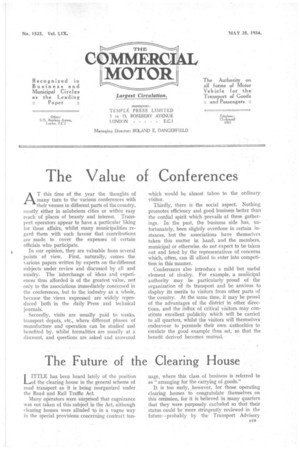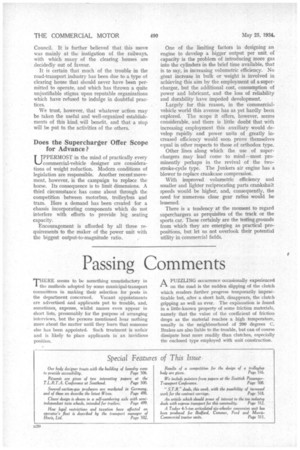The Future of the Clearing House
Page 37

Page 38

If you've noticed an error in this article please click here to report it so we can fix it.
LITTLE has been heard lately of the position of the clearing house in the general scheme of road transport as it is being reorganized under the Road and Rail Traffic Act.
Many operators were surprised that cognizance was not taken of this subject in the Act, although clearing houses were alluded to in a vague way in the special provisions concerning Contract ton nage, where this class of business is referred to as "arranging for the carrying of goods."
It is too early, however, for those operating clearing houses to congratulate themselves on this omission, for it is believed in many quarters that they were purposely excluded so that their status could be more stringently reviewed in the future—probably by the Transport Advisory Council. It is further believed that this move was mainly at the instigation of the railways, with which many of the clearing houses are decidedly out of favour.
It is certain that much of the trouble in the road-transport industry has been due to a type of clearing house that should never have been permitted to operate, and which has thrown a quite unjustifiable stigma upon reputable organizations which have refused to indulge in doubtful practices.
We trust, however, that whatever action may be taken the useful and well-organized establishments of this kind. will benefit, and that a stop will be put to the activities of the others.
Does the Supercharger Offer Scope for Advance ?
UTPPERMOST in the mind of practically every %b.-1 commercial-vehicle designer are considerations of weight reduction. Modern conditions of legislation are responsible. Another recent movement, however, is the campaign to replace the horse. Its consequence is to limit dimensions. A third circumstance has come about through the competition between motorbus, trolIeybus and tram. Here a demand has been created for a chassis incorporating components which do not interfere with efforts to provide big seating capacity.
Encouragement is afforded by all three requirements to the maker of the power unit with the biggest output-to-magnitude ratio. One of the limiting factors in designing an engine to develop a bigger output per unit, of capacity is the problem of introducing more gas into the cylinders in the brief time available, that is to say, in increasing volumetric efficiency. No great increase in bulk or weight is involved in achieving this aim by the employment of a supercharger, but the additional cost, consumption of power and lubricant, and the loss of reliability and durability have impeded development.
Largely for this reason, in the commercialvehicle world this avenue has as yet hardly been explored. The scope it offers, however, seems considerable, and there is little doubt that with increasing employment this auxiliary would develop rapidly and power units of greatly increased efficiency would soon prove themselves equal in other respects to those of orthodox type.
Other tines along which the use of superchargers may lead come to mind—most prominently perhaps in the revival of the twostroke-cycle type. The Junkers air engine has a blower to replace crankcase compression.
With improved volumetric efficiency and smaller and lighter reciprocating parts crankshaft speeds would be higher, and, consequently, the need for numerous close gear ratios would be lessened.
There is a tendency at the moment to regard superchargers as perquisites of the track or the sports car. These certainly are the testing grounds from which they are emerging as practical propositions, but let us not overlook their potential utility in commercial fields.




































































































